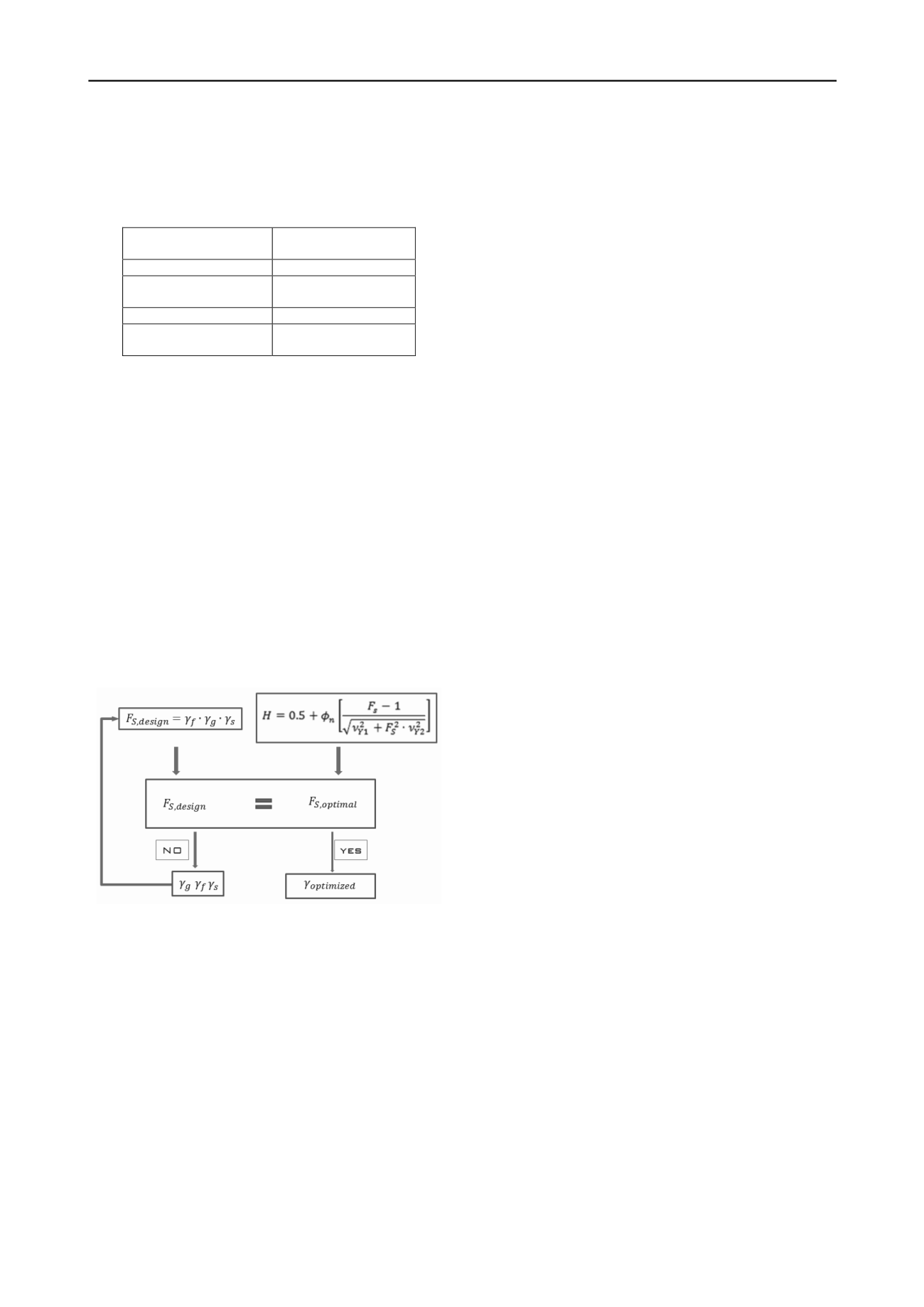
2802
Proceedings of the 18
th
International Conference on Soil Mechanics and Geotechnical Engineering, Paris 2013
.
(32)
Some reference guiding values for the coefficient of variation of
the geotechnical parameters are presented in Table 1.
Table 1. Reference values of geotechnical properties of de soil.
Parameter
Coefficient of
variation
Specific weigh
0.05
Tangent of friction
angle
0.07
Cohesion
0.1
Shear undrained
resistance
0.15
In this way, it is possible to obtain the coefficient of variation of
the load ( )
p
and the ultimate bearing capacity of the PR
,
(
PR ult
Q
)
. With this and a defined safety level, the
,
s o
F
can be
calculated. Quevedo (2002) recommended to use a safety level
, in the geotechnical designs by the ultimate limits
states. It means a failure probability of 0.02.
0,98
H
In order to know if the partial safety coefficients used in a
specific design are appropriated, a comparison between
,
s o
F
and
,
s d
F
has to be done. Generally, the coefficients used in
regular designs are conservative and they have to be calibrated
to find one or more combinations that make
,
s o
F
equal to
,
s d
F
.
In practice, because the variability of the load is lesser known,
or measured, than the geotechnical parameters, it is better to
reduce the weighting coefficient of the parameters of the soil.
Also, it is easier for engineers to use the same weighted load for
structures and foundations projects alike. Figure 2 shows the
algorithm that resumes the method of calibration.
Figure 2. Algorithm for obtaining safety factors by LEM (Lorenzo
2010)
5 CONCLUSIONS
The cost of the (more) rational approach for the foundation
design methods is the increase of the complexity level.
Nevertheless, this cost is compensated by a proportional
advantageous decrease of the execution costs. Besides, it will
enhance the understanding of the design and yield a better
assurance of its related variables. Thus, the use of the safety
theory is the first step to obtain a more economical and rational
design.
The PRF analysis approach for a foundation system leads to an
effective and optimized use of its components (Cunha et al.
2001), as it allows the raft-soil contact contribution both in the
overall stiffness and load capacity of the system. This analysis
is a generalization of the calculation methods for determining
the bearing capacities of raft and pile groups separately.
Based on the method proposed by Sanctis & Mandolini (2006),
a methodology for the application of the LEM in the design of
PR was established. The use of three sets of partial coefficients
allow to separately consider the uncertainties introduced in the
design of the materials, the loads and the working conditions.
By means of the methodology described by Quevedo (2002) it
is possible to calibrate the partial safety coefficients which are
necessary for the application of the LEM in the design of PRF
systems. This makes it possible to better define and understand
the safety level to be achieved in design.
6 ACKNOWLEDGEMENTS
The authors acknowledge the support of the National Brazilian
Agency CNPq and the Geotechnical Graduation Prog. of the
UnB for all related funds that allowed this particular research.
7 REFERENCES
Cunha, R.P., Poulos, H.G. and Small, J.C. (2001). “Investigation of
design alternatives for a piled raft case history”. ASCE Journal of
Geotechnical and Geoenvironmental Engineering, August, 127(8),
pp. 635-641.
Poulos, H.G. & Davis, E.H. (1980). “Pile Foundation Analysis and
Design”. John Wiley & SonsEd., New York.
Randolph, M. F. (1983). “Design of piled raft foundation”. Proc. Int.
Symp. on Recent Developments in Laboratory and Field test and
Analysis of Geotechnical Problems, Bangkok, pp. 525-537.
Sales, M.M. (2000). “Análise do comportamento de sapatas
estaqueadas”. Tese de doutorado, Publicação GTD/0022.
Universidade de Brasília-DF, pp. 229.
Carsten, A. & Dmitri, S. (1998). “Combined Piled-Raft Foundation
(CBRF), Safety Concept”. Universitat Leizpig, pp. 13.
Quevedo, G. (2002). “Aplicación de los Estados Límites y la teoría de la
Seguridad en el Diseño Geotécnico en Cuba”. Tesis de Doctorado
en Ciencias, UCLV, Santa Clara, pp.163.
Eurocódigo 7. (2005). “Proyecto Geotécnico. Reglas generales”.
European committee for standarization. Brussels, Bélgica, pp. 119.
Caneiro J. H. (2003). “Apuntes para libro Diseño de Hormigón
Estructural”. Instituto Superior Politécnico José Antonio
Echeverria. La Habana. Cuba.
Mandolini, A. (2003). “Design of piled raft foundations: practice and
development”. Proc., Geotech. Int. Seminar Deep Foundation on
Bored and Auger Piles, BAP IV, Van Impe and Haegeman, eds.,
pp. 59–80.
Sanctis de L. & Mandolini A., (2006). “Bearing Capacity of Piled Raft
on Soft Clay Soils”. Journal of Geotech. and Geoenvironmental
Eng. vol. 132, no. 12 , pp. 11.
Jiménez Salas, J.A.; Justo Alpañes, J. L.; Serrano, A. A. (1981)
“Geotecnia y cimientos III : Mecánica del suelo y de las rocas.” 2da
Edición. Madrid : Editorial Rueda, pp. 1188
Randolph, M.F. (1994). “Design Methods for Pile Groups and Piled
Rafts”. Proc. of the 13th Inter.Conf. on Soil Mechanics and Found.
Eng. New Delhi. 5, pp. 1-21.
Quevedo, G. (1987) “Aplicación del Método de los Estados Límites en
el diseño de las cimentaciones superficiales”. Revista Ingeniería
Estructural. 2(III), pp. 95 - 106.
González - Cueto, A. V. (2000). “Diseño Geotécnico de Cimentaciones
Superficiales en Arenas.” Tesis de Doctorado, Universidad Central
de Las Villas, Santa Clara, pp. 133.
Lima, R. (2006). “Diseño de cimentaciones sometidas a grandes
esfuerzos de momentos y/o cortantes y axiales pequeños o de
succión”. Tesis de Maestría. Univ. Central de Las Villas, pp. 99.
Becker D. E. (1996). “Eighteenth Canadian Geotechnical Colloquium:
Limit States Design for Foundations”. Part I. An overview of the
foundation design process.” Canadian Geotechnical Journal 33, pp.
956 – 983.
Lorenzo, R. (2010). “Diseño Geotécnico de Losas Pilotadas. Aplicación
de la Teoría de Seguridad”. Tesis de Maestría. CEDEX, Madrid,
pp.123.
CTE. (2006). “Código Técnico de la Edificación”. Ministerio de la
Vivienda, España, 1061p.


